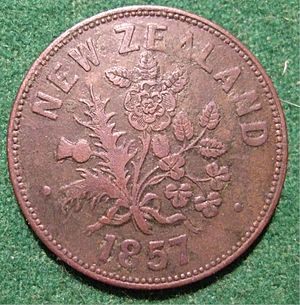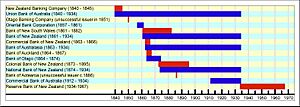New Zealand pound facts for kids
Quick facts for kids New Zealand pound |
|
|---|---|
| User(s) | New Zealand, Cook Islands, Niue, Pitcairn Islands, Tokelau |
| Subunit | |
| 1⁄20 | shilling |
| 1⁄240 | penny |
| Symbol | £ |
| shilling | s or / |
| penny | d |
| Coins | 1⁄2d, 1d, 3d, 6d, 1/–, 2/–, 2/6 |
| Banknotes | 10/–, £1, £5, £10, £50 |
The pound (symbol £) was New Zealand's money from 1840 until 1967. It was replaced by the New Zealand dollar. Just like the British pound, it was divided into 20 shillings. Each shilling was then divided into 12 pence.
Contents
A Look Back: The History of the New Zealand Pound
The New Zealand pound was once worth the same as the British pound. This lasted until World War I began.
Changes During the Great Depression
In the early 1930s, a tough time called the Great Depression hit the world. This made it hard for New Zealand to sell its farm products to the UK. Banks in Australia, which managed New Zealand's money exchange with London, changed the value of the New Zealand pound in 1933. It became worth less than the British pound. For example, £NZ 1 was then worth 16 shillings sterling, instead of a full £1. But by 1948, the New Zealand pound was back to being worth the same as the British pound.
Switching to the New Zealand Dollar
In 1967, New Zealand changed its money system to a decimal system. This means money was based on units of 100, like cents in a dollar. The pound was replaced by the dollar. For every £NZ 1, you would get $NZ 2. So, $NZ 1 was worth 10 shillings. Later that year, the British pound also lost some value. The New Zealand dollar was also lowered in value to match the Australian dollar.
Coins of the New Zealand Pound
At first, New Zealand used coins from Britain and Australia. But because the New Zealand pound became worth less than the British pound in the 1930s, New Zealand started making its own coins in 1933.
New Zealand's Own Coins
The first New Zealand coins were 3 pence, 6 pence, 1 shilling, 2 shillings (also called a florin), and 2 shillings and 6 pence (a half-crown). These coins were made of 50% silver until 1946. After that, they were made from a mix of copper and nickel. In 1940, smaller half-penny and 1 penny coins made of bronze were added. All these coins were the same size and weight as similar coins in Australia and the UK. Unlike the UK, New Zealand kept using its smaller silver three-penny coin until 1967.
| Reverse Image | Value | Equivalent in cents (c) | Technical Parameters | Description | Date of | ||||||
|---|---|---|---|---|---|---|---|---|---|---|---|
| Diameter | Thickness | Mass | Composition | Edge | Obverse | Reverse | Issue | Withdrawal | |||
 |
1⁄2d (half penny) | 0.4167c | 26 mm | 5.7 g | Bronze | Plain | King George VI (1940–52) Queen Elizabeth II (1953–67) |
A Māori hei-tiki (neck pendant) with ornamental tukutuku patterns on each side | 1940 | ||
 |
1d (one penny) | 0.8333c | 31 mm | 9.5 g | A tūī perched in a setting of yellow kowhai blossoms | ||||||
| 3d (three pence) | 2.5c | 16 mm | 1.4 g | 50% silver (1933–1946) Cupronickel (1947–1967) |
Plain | King George V (1933–1936) King George VI (1937–1952) Queen Elizabeth II (1953–1967) |
Two carved patu (Maori weapons) crossed with lanyards or throngs attached, with “3d” between their blades | 1933 | |||
| 6d (six pence) | 5c | 19 mm | 2.9 g | Continuously milled | A huia perched on a branch | 31 October 20061 | |||||
 |
1/– (one shilling) | 10c | 23 mm | 5.7 g | A figure of a Maori warrior in warlike attitude carrying a taiaha | ||||||
 |
2/– (2 shillings, a.k.a. one "florin") | 20c | 28.5 mm | 11.3 g | A kiwi facing left | ||||||
 |
2/6 (2+1⁄2 shillings, 2 shillings and 6 pence, or "half crown") | 25c | 32 mm | 14.1 g | Arms of New Zealand on a background of Māori carvings. | ||||||
| These images are to scale at 2.5 pixels per millimetre. For table standards, see the coin specification table. | |||||||||||
Notes:
- Some old coins, like the sixpence, shilling, and florin (2 shillings), were still legal to use until 2006. This is because they were the same size and value as the new 5c, 10c, and 20c coins. They were officially taken out of circulation on October 31, 2006.
Special "crown" coins (worth five shillings) were made for important events. These included the Treaty of Waitangi in 1935, a royal visit in 1949, and the crowning of Queen Elizabeth II in 1953.
Banknotes of the New Zealand Pound
Before 1934, many different private banks printed their own banknotes in New Zealand. The first bank notes were issued in March 1840 by the Union Bank of Australia.
Early Banknote Issuers
Many banks issued notes in New Zealand over the years:
- Union Bank of Australia (1840–1934)
- New Zealand Banking Company (1840–1845)
- Colonial Bank of Issue (1847–1856)
- Bank of New South Wales (1861–1934)
- Bank of New Zealand (1861–1934)
- Bank of Australasia (1863–1934)
- National Bank of New Zealand (1874–1934)
- Commercial Bank of Australia (1912–1934)
Between 1852 and 1856, the Colonial Bank of Issue was the only bank printing notes. But people didn't trust these notes much. Later, when gold was discovered in 1861, more banks came to New Zealand, and many different notes were used. By 1924, the six banks still printing notes agreed to make them all the same size and color for each value. This made them easier to use.
The Reserve Bank Takes Over
The Reserve Bank of New Zealand was created on August 1, 1934. After this, it became the only place allowed to print banknotes. This government bank introduced notes for 10 shillings, £1, £5, and £50. In 1940, £10 notes were also added.
Only two types of £1 notes were printed by the Reserve Bank. The first (1934–1940) showed a picture of Matutaera Te Pukepuke Te Paue Te Karato Te-a-Pōtatau Tāwhiao, a Māori king. The second (1940–1967) featured Captain James Cook.
When the dollar was introduced, these notes were still being used:
- 10 shillings (which became $1)
- £1 (which became $2)
- £5 (which became $10)
- £10 (which became $20)
- £50 (which became $100)
What Happened to the Old Money?
Old coins and banknotes from the New Zealand pound era can still be exchanged. You can take them to the Reserve Bank of New Zealand in Wellington. The Reserve Bank is required to exchange these old notes.
Today, these old coins and notes are usually worth much more to collectors than their original value. This is because they are rare. For example, a £1 note from the Union Bank from the 1840s would be worth over £10,000 sterling to a collector today! The £NZ 50 notes from the Reserve Bank are also very rare and can sell for a high price. Some notes signed by Chief Cashier T. P. Hanna, if in perfect condition, could be worth as much as $NZ 25,000 to collectors.



